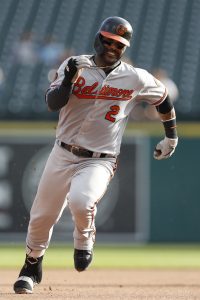We’re less than a week removed from analyzing how the five largest expiring contracts on the pitching side have panned out. We’ll do the same here with five big-money hitters who are scheduled to reach free agency in about a month. Notable omission: Red Sox designated hitter/outfielder J.D. Martinez, who’s far from a sure thing to opt out of the three years and $62.5MM that remain on his contract.
Ryan Zimmerman, 1B, Nationals (six years, $100MM, including $2MM buyout for 2020 and $10MM personal services contract that begins when career ends)
Total fWAR: 5.2
Dollar value of contributions (per FanGraphs): $41.7MM
- The Nationals made the decision in 2012 to extend Zimmerman, then a star third baseman, though the contract didn’t kick in until 2014. Aside from a resurgent 2017, Zimmerman hasn’t been particularly valuable since Washington awarded him his lucrative accord. Injuries have been a consistent problem for Zimmerman along the way, including during a 190-plate appearance 2019 in which the 35-year-old mustered a less-than-stellar .257/.321/.415 line with six home runs. Those type of numbers don’t really play anywhere, especially at first base – which has become Zimmerman’s lone position. He hasn’t lined up at the hot corner since the first season of his deal. Once their season ends, the Nats will buy Zimmerman out for $2MM in lieu of bringing him back for an unpalatable $18MM.
Russell Martin, C, Dodgers (five years, $82MM)
Total fWAR: 12.5
Dollar value of contributions: $99.6MM
- As a free agent in November 2014, Martin returned to his native Canada on an expensive contract with the Blue Jays. It worked out beautifully for the Jays during the first few years, but the rebuilding club elected to send Martin and the majority of the money left on his deal to the Dodgers – with whom he began his career – last January. The well-respected 36-year-old has remained a useful player in 2019, though he’s no longer the starting-caliber catcher he has been for most of his career. Martin, who has taken a backseat to Dodgers rookie Will Smith, has hit .220/.337/.330 with six HRs in 249 PA on the offensive side. Defensively, Martin’s still an above-average option, according to Baseball Prospectus’ Fielding Runs Above Average metric.
Alex Gordon, LF, Royals (four years, $72MM, including $4MM buyout for 2020)
Total fWAR: 3.3
Dollar value of contributions: $26.3MM
- Gordon’s contract, which still stands as the largest the Royals have ever given out, hasn’t provided the on-field value KC was hoping for when it re-signed him off a World Series-winning campaign. Gordon remains an immensely respected figure with the franchise, though, and if the soon-to-be 36-year-old decides to continue his career in 2020, it appears the Royals will welcome him back. First things first, the club will decline its half of a $23MM mutual option in favor of a $4MM buyout, meaning Gordon will have to sign a new, much cheaper contract should he play next season.
Jose Abreu, 1B/DH, White Sox (six years, $68MM)
Total fWAR: 17.9
Dollar value of contributions: $141.5MM
- Abreu’s the sole player on this list who’s setting up to make out well on his next deal, thanks in part to a late-season surge. The 32-year-old could even get a qualifying offer before hitting free agency, though he and the White Sox probably hope it doesn’t come to that. Both sides have publicly gushed over one another on several occasions, so it wouldn’t be remotely surprising to see the White Sox and Abreu shake hands on a fresh deal sometime in the next few weeks. Regardless, the franchise-record contract the White Sox gave Abreu as a Cuban emigree in 2013 has provided tons of surplus value for the team.
Starlin Castro, 2B, Marlins (seven years, $60MM, including $1MM buyout for 2020)
Total fWAR: 10.6
Dollar value of contributiions: $83.4MM
- Plenty has changed for Castro since he landed his contract as an up-and-coming player in 2012. For one, he was a shortstop at that point – a player the Cubs thought would be a long-term building block. But Castro was inconsistent from 2013-15, the first three years of his deal, leading the Cubs to trade him to the Yankees. Castro’s so-so production continued in New York from 2016-17, after which the Yankees offloaded him to the Marlins in a salary-dumping move that made it easier for the Bronx Bombers to take on Giancarlo Stanton’s massive contract. The now-second baseman has essentially been the same player in Miami, a notoriously low-budget outfit that will buy him out for $1MM this offseason instead of exercising its $16MM option over him for 2020. Set to turn 30 in March, Castro will venture to the market on the heels of a 1.3-fWAR season in which he batted .270/.300/.436 and smacked 22 homers over 676 PA.





